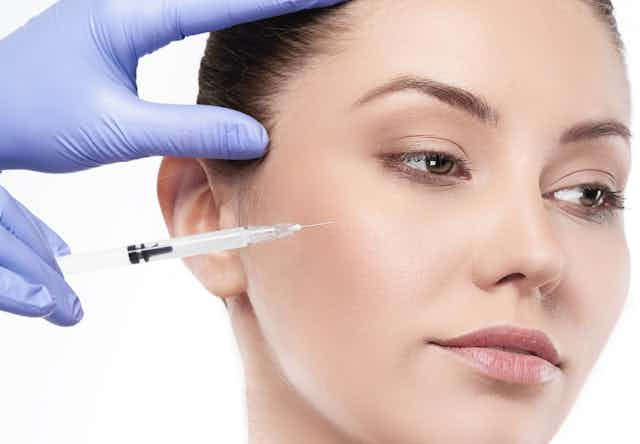The battle against wrinkles has lasted for centuries. Long before surgical facelifts, people ingested powders and potions, stretched their faces using thread and tape, and rubbed their skin with Crisco, acid and animal blood to fight the signs of aging.
But when the FDA approved Botox for cosmetic use in 2002, it forever changed the anti-aging market. Since then, 11 million Americans have been forking over hundreds of dollars per session to have a licensed provider inject the drug into their facial muscles, a process that temporarily paralyzes their facial movement and erases existing wrinkles.
Capitalizing on cultural pressure for women’s bodies and faces to stay forever young, Botox manufacturer Allergan started marketing the product to the typical middle-aged everywoman. It paid off: Over 90 percent of users are women. Almost 60 percent are between the ages of 45 and 54.
However, a small – but growing – number of younger women have started turning to this anti-aging “wonder drug.” Today, almost 20 percent of Botox users are in the 30-39 age demographic. Responding to the advice of many dermatologists who preach prevention, these young women are using Botox as a deterrent, hoping that it will halt the development of facial creases and wrinkles down the road.
In my forthcoming book “Botox Nation,” I show how Botox is now aggressively marketed to young women as a drug with curative and preventive powers that can permanently prolong the appearance of youth.
A lifetime of maintenance
The belief that Botox is preventive has been circulating for almost as long as the drug itself. The idea is that long-term paralysis of facial movement will mean no facial wrinkles. It’s a theory promoted in magazine articles by beauty and medical “experts” who tell young women that the best time to start using Botox is when their wrinkles are minimally visible.
However, the theory of preventative Botox use is flawed. Botox’s ability to freeze the youthful face is fleeting: The effect only lasts four to six months. So because Botox’s effects are temporary, they only really prevent wrinkles if you get injections two to three times a year. Botox may conceal wrinkles, but as soon as an individual stops using Botox, those wrinkles reappear. To start young, then, means to enlist in a lifetime of treatment.
Nonetheless, media messages about Botox regularly advocate these proactive efforts, oftentimes glossing over the fact that repeat injections are required.
In my research I found that news coverage of Botox was peppered with preventative claims, such as “You want to clean up your room before it gets too dirty” or “I do tons of Botox because I believe in holding yourself in place to prevent aging.”
Likewise, when I interviewed young Botox users, they told me things like “I use Botox because it’s a preemptive strike” and “If you start using Botox early, it totally prevents your lines from getting deeper.” There was the general feeling among users that you should begin a lifelong regimen of preventative aesthetics early in life – before reaching thirty – in order to gradually “freeze” your youthful look in place. To them this was preferable to starting treatment at a later age – after wrinkles had emerged – which would drastically alter the face’s appearance, making it obvious that it had been treated.
The fact that young, wrinkle-free women are freezing their faces in time speaks volumes about the demands American culture places on women to stay young and beautiful.
Treatments become ‘crack like’
Regular visits to the Botox doctor come at a financial – and, in some cases, physical – cost.
The expense of a single Botox treatment is between US$300 and $400, which initially seems much more affordable than a face-lift (a procedure that can cost upwards of $6,000). However a woman who starts using Botox in her 20s or 30s will end up spending much, much more if she undergoes regular treatments to prevent the effects from wearing off.
It should also be noted that Botox is derived from botulism, the deadliest toxin on the planet. Even though the drug is, for the most part, safe, there have been reports of adverse effects , including blurred vision, ptosis (drooping eyelids), slurred speech and progressive muscle weakness. Among the Botox users I interviewed, a handful reported suffering from debilitating headaches for days after the injection. One woman suffered from ptosis.
Botox’s temporary results can also lead to compulsive, repetitive behaviors. In my interviews, many women said they weren’t able to stop the treatments. They spoke of Botox as if it were a drug, one that left them dependent on its short-lived effects. As one woman told me, she was “crack-like” about her Botox injections, rushing to her dermatologists’ office the moment she noticed faint brow wrinkles. Not only did women report feeling addicted to Botox, it also seemed serve as a gateway to other cosmetic procedures, such as dermal fillers.

The multi-billion-dollar beauty and anti-aging industry cultivates feelings of personal inadequacy to convince people to buy their products.
For example, one advertisement for Botox asserted: “It is really up to you. You can choose to live with wrinkles. Or you can choose to live without them.” This projects the message that control over our aging faces is putatively in our grasp. If we “choose to live” with our wrinkles, we are complicit in our own aging and, therefore, have consciously decided to not live up to society’s standards of beauty.
As long as women are held to these unattainable standards, the urge to freeze the face in place will persist.

